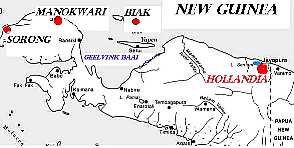|
In Sorong we received the bad news that our mail had burned up in an accident. We marched along a muddy jungle trail to a new campsite of the Dutch Marines, who had recently arrested some Indonesian infiltrants on the island of Gag, a colonel and two lieutenants posing as "gardeners". We also enjoyed the beaches with fantastic shells and the clear oceanwater with its fabulous variety of multi-colored fish - quite a change from Dutch waters! One day we saw a devil ray jump up about 18 feet and splash back causing a sound like a canon shot.
|
1952 Training Cruise on the
"van Kinsbergen", to New Guinea,part 9

The "Geelvink Baai" is named after the spectacular Bird of Paradise, which though beautiful produces some rather awkward sounds |
In April, we sailed to the island of BIAK, where the Japanese regrouped in 1944; some 20,000 Japanese were forced into cannibalism and were burned alive in caves where they had hidden from the invading Allied troops. We also visited Manokwari and met several ex-Dutch East Indies planters trying their luck here. We traded Douwe Egberts heavy "shag" for bows, arrows and spears which I later donated to the Wilhelmina School in Amstelveen, Holland. Biak is known for the "Mata Biak", the operculum of a crab which can be used for bracelets; hermit-crabs were very abundant and served as "toys" decades before they became the rage in the USA.
|

